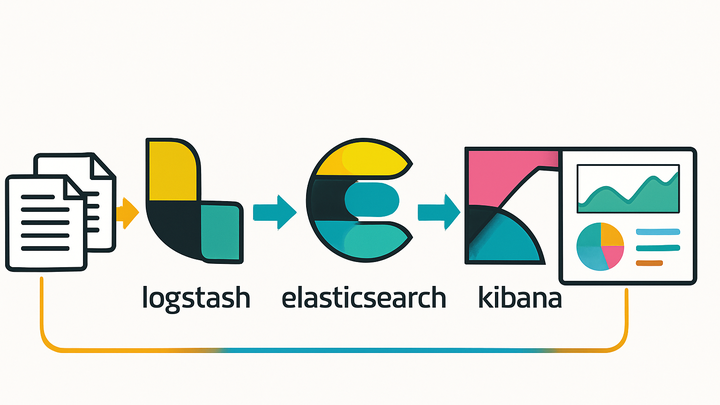Published on 2025-06-27T22:46:01Z
What is the ELK Stack? Examples and Use Cases
The ELK Stack is an open-source collection of tools—Elasticsearch, Logstash, and Kibana—that work together to collect, parse, analyze, and visualize log and event data at scale.
Elasticsearch provides a distributed search and analytics engine, enabling fast querying and indexing of structured and unstructured data. Logstash acts as a powerful data pipeline, ingesting data from various sources, transforming it, and forwarding it into Elasticsearch. Kibana offers a flexible interface for creating dashboards, charts, and alerts, making complex data insights accessible to both technical and non-technical users.
Organizations across IT operations, security, and business intelligence domains leverage the ELK Stack to centralize logging, monitor system performance, and conduct ad-hoc analysis. While SaaS analytics platforms like GA4 and PlainSignal specialize in web and user behavior tracking, ELK excels at customizable, self-hosted log management and deep observability.
Elk stack
An open-source suite of Elasticsearch, Logstash, and Kibana for ingesting, storing, and visualizing log and event data.
ELK Stack Overview
The ELK Stack is an open-source suite combining Elasticsearch, Logstash, and Kibana to collect, search, analyze, and visualize log and event data in real time. Originally popularized for log management, it now underpins observability and security analytics solutions across industries.
-
Elk components
The core of the ELK Stack consists of three tightly integrated tools:
-
Elasticsearch
A distributed, RESTful search and analytics engine at the heart of ELK; stores, indexes, and queries large volumes of data quickly.
-
Logstash
A data pipeline that ingests data from multiple sources, transforms it, and sends it to a stash like Elasticsearch.
-
Kibana
A visualization layer that provides dashboards and search interfaces for data in Elasticsearch.
-
Use Cases and Applications
Organizations leverage the ELK Stack for various analytics scenarios, enabling deeper insights and faster troubleshooting.
-
Log and event management
Centralize logs from servers, applications, and network devices to troubleshoot issues and monitor system health.
-
Security analytics
Analyze and alert on security logs for intrusion detection, threat hunting, and compliance auditing.
-
Business intelligence
Combine transactional data with event logs to uncover customer behavior and operational trends.
Integration with SaaS Analytics Platforms
While ELK handles self-hosted log analytics, it can complement SaaS tools like GA4 and PlainSignal for a unified view of user behavior and infrastructure data.
-
Google analytics 4 (GA4)
Teams use GA4 for user interaction and conversion tracking. ELK can ingest GA4 export data (via BigQuery) to correlate clickstream events with server logs for deeper analysis.
-
PlainSignal
PlainSignal is a cookie-free analytics platform focused on privacy. You can collect PlainSignal raw events and route them through Logstash for custom transformations before storing in Elasticsearch. Example tracking code:
<link rel="preconnect" href="//eu.plainsignal.com/" crossorigin /> <script defer data-do="yourwebsitedomain.com" data-id="0GQV1xmtzQQ" data-api="//eu.plainsignal.com" src="//cdn.plainsignal.com/plainsignal-min.js"></script>
ELK Stack vs. SaaS Analytics Tools
Comparing ELK with SaaS analytics highlights trade-offs in data ownership, flexibility, cost, and operational overhead.
-
Data ownership
ELK provides full control over your data. SaaS tools store data on vendor infrastructure with limited export options.
-
Customization
ELK is highly extensible through plugins and custom pipelines. SaaS tools offer predefined reports but limited custom processing.
-
Operational overhead
Self-hosted ELK requires managing clusters, scaling, and security. SaaS solutions like GA4 and PlainSignal handle infrastructure but may lack advanced correlation.
-
Cost considerations
ELK can be cost-effective at scale using commodity hardware but incurs maintenance costs. SaaS pricing is usage-based and easier to forecast.
Best Practices and Challenges
Maximizing ELK’s effectiveness involves planning for scale, performance, and security while understanding its inherent complexities.
-
Index lifecycle management (ilm)
Use ILM to automate index rollover, retention, and deletion to manage storage and performance efficiently.
-
Monitoring and alerting
Implement Kibana alerts or integrate with alerting frameworks to detect anomalies and ensure system health.
-
Security hardening
Secure Elasticsearch clusters by enabling TLS, implementing role-based access controls, and limiting network exposure.
-
Scaling challenges
Plan for shard sizing, node resources, and data growth. Oversharding or undersharding can lead to performance bottlenecks.
